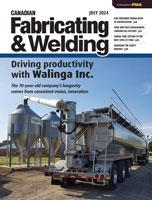- FMA
- The Fabricator
- FABTECH
- Canadian Metalworking
Laser Scanning
Creating a CAD model directly from point cloud data saves time and improves quality
- October 1, 2010
- Article
- Measurement
Laser scanning is becoming popular in reverse-engineering projects and lately has made inroads into part inspection in production environments. Delicate items also can be measured without the need to make physical contact with them.
Laser scanning devices also have become portable, no longer tethered to a dedicated measurement room, and can be set up quickly and easily on the shop floor. This ability to scan on location reduces measurement time and the effort of moving parts, which often are large and unwieldy, around the manufacturing workspace.
“Portable, 3-D imaging technology in the reverse-engineering and inspection fields is becoming more and more popular for a variety of reasons,” said Giles Gaskell, Wenzel/Xspect Solutions North American sales manager for 3-D imaging products. “For example, when you need to scan something that is part of a large machine and cannot be detached, that’s a situation when you are only able to scan using a device that’s portable.”
Also, if you need to measure the wear on a stamping tool while it is still in a press you can either use a portable device and measure the tool between shifts or stop production and remove the tool for measurement elsewhere.
Some laser scanners, such as Wenzel’s MobileScan3D®, are no longer constrained by a coordinate measuring machine (CMM) frame or even a scanning arm. This device has interchangeable laser sensors to adapt to different sizes and shapes of parts up to 2 m long.
The quality of the data the scanner creates, combined with the CNC’s repeatability, results in unique scanning ability that is portable and flexible.
The laser scanner comprises a two-axis, CNC swivel head providing A and B rotational axes. The scanning sensor itself is mounted to the swivel head using a quick-change adapter, minimizing changeover times among the three available sensors.
This system also has three-axis CNC capability and uses a red laser stripe to scan up to 100,000 points per second.
“This laser beam line moves over the object and is tracked by a camera,” explained Gaskell. “The camera sees the shape of the line as it travels, and that is what it uses to create the three-dimensional point cloud. You then use this point cloud to create the CAD model.”
The system achieves scanning accuracy down to 10 microns, and the density of scanned lines can be controlled by programming the velocity of the A and B axes of the swivel head. Integral thermal sensors with environmental control ensure scanned data set accuracy. The sensor body is manufactured from carbon fiber, eliminating any thermal growth caused by heat generated from the laser source.
“Not only is laser scanning much faster than manual probing, for example, but it also creates an exact representation of the part based on the point cloud. This gives a comprehensive measurement of all points on the object, not just those that were touched by a probe,” Gaskell said.
Reverse Engineering
Reverse engineering of both simple and complex parts can be aided through the use of a laser scanning device. Since scanning time is reduced by faster data collection, the time to create a part is also reduced. Also, because the data collected extremely accurate, trial-and-error manufacturing can be eliminated.
“Most of the 3-D imaging companies have very good products when it comes to reverse engineering,” said Gaskell. “From the tiniest piece of jewelry up to, literally, a ship, there are devices of different types that can scan these items with a laser.”
Part Verification
According to Gaskell, one growth area for laser scanners is in the verification of production parts against nominal geometry data.
“Where noncontact scanning technology has really evolved in the past few years is in the scanning of shiny surfaces,” explained Gaskell.
According to Gaskell, another new machine, the Wenzel ScanTec CORE measuring machine uses multiaxis, noncontact high intensity spot scanning technology and still offers the accuracy and repeatability of a CNC CMM. In addition, faster scanning speeds are possible because it does not touch the part.
“This is a great advancement in noncontact scanning for metalworking shops,” added Gaskell. “In most production environments, finished metal parts are usually measured by being touched in some way, and that slows the process down.”
Previously shiny parts, such as those that have just been machined, would have to be coated or painted prior to scanning to ensure that the laser or white light did not reflect back off the surface, creating an incorrect measurement.
“Now, newly created parts can be scanned and verified fresh from the machining process with no need for a coating,” said Gaskell. “In high-tolerance machining, sometimes you cannot afford even the smallest change to a part. This new optical scanner eliminates the need for any kind of coating.”
With noncontact scanning, the bottleneck that is usually seen in the measurement process can be eliminated.
“Being able to reliably measure production parts on the shop floor is becoming a reality now,” said Gaskell. “It’s an exciting time to be involved in noncontact scanning as this emerges.”
For more information, visit www.wenzelamerica.com.
subscribe now


Keep up to date with the latest news, events, and technology for all things metal from our pair of monthly magazines written specifically for Canadian manufacturers!
Start Your Free Subscription- Trending Articles
- Industry Events
IMTS 2024
- September 9 - 14, 2024
- Chicago, IL
WiM Summit 2024
- October 6 - 9, 2024
- Boston, MA
FABTECH 2024 Orlando
- October 15 - 17, 2024
- Orlando, FL















